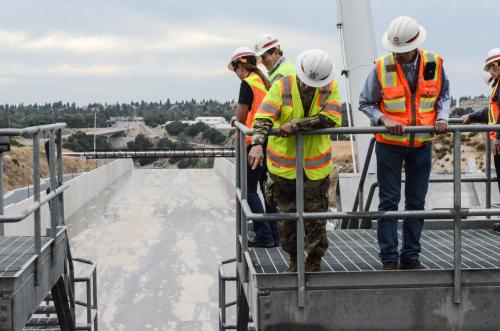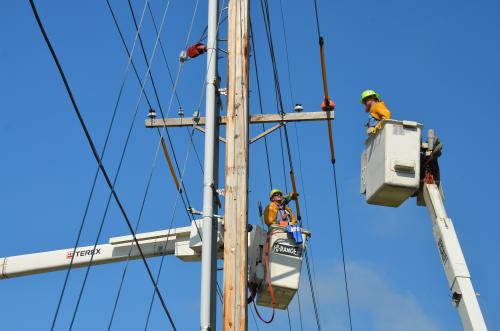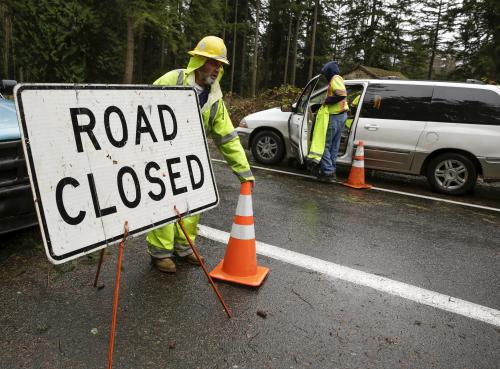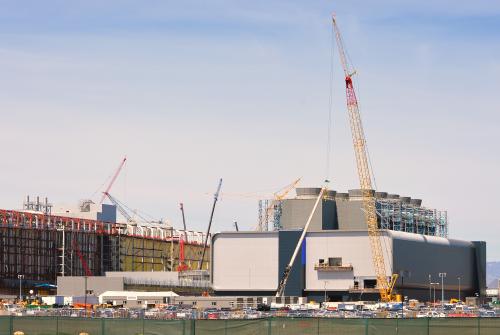Following a week-long focus on infrastructure, President Trump revealed few additional details on his long-awaited $1 trillion plan. His announcement to privatize air traffic control and the steps he outlined to streamline infrastructure permitting rehashed ideas that have been around for some time.
However, one interesting new point did emerge: an infrastructure workforce training initiative. In a short set of visuals released by the White House, the initiative proposes to focus on skills-based apprenticeship education and support up to one million apprentices over two years. While the initiative lacks many specifics, it represents one of the more tangible infrastructure goals spelled out by the administration up to this point–and may offer insight into a broader range of workforce development efforts still to come.
But can Trump, perhaps best known for his experience on “The Apprentice” when dealing with labor market issues, design and deliver a program that tackles the infrastructure investment gap while providing clearer pathways to economic opportunity?
But can Trump, perhaps best known for his experience on “The Apprentice” when dealing with labor market issues, design and deliver a program that tackles the infrastructure investment gap while providing clearer pathways to economic opportunity?
The initial evidence seems less than promising. First, his budget’s proposed cuts to federal job training programs do not square with his more recent and ambitious pronouncements. Second, the lack of clarity on what these apprenticeship efforts would exactly entail is also concerning, including how any new efforts would gel with existing federal programs and how they would ultimately identify the specific workers (and skillsets) to be prioritized.
Yet if this week’s announcement is really just a starting point, it is an opportune time to design a new federal infrastructure apprenticeship program from the ground up. Ideally, such a program would respond to the depth and breadth of opportunities present in this segment of the labor market, based on several guiding principles:
- Scale to national needs. Supporting one million apprenticeships over two years sounds ambitious, but it roughly aligns with industry needs. Across the country, 14.5 million workers, or 11 percent of the U.S. workforce, help construct, operate, and maintain infrastructure, often over many years. And since many of these workers are nearing retirement, up to three million will need to be replaced over the next decade, which will require recruiting, training, and retaining a new generation of workers.
- Broaden infrastructure’s scope. Infrastructure workers are involved in all types of projects and touch nearly every market across the country, meaning that workforce development efforts must focus on a variety of different industries, occupations, and regions. Infrastructure goes far beyond roads and bridges, and any future plans must recognize needs in the country’s transit systems, water utilities, and warehouses, among other facilities. For example, up to 39 percent of subway operators and 33 percent of cargo agents will need to be replaced over the next decade.
- Design flexible training programs. Most infrastructure workers tend to learn on the job and require lower levels of formal education: 80 percent typically have short- to long- term on-the-job training, but only 12 percent hold a bachelor’s degree or higher. As result, apprenticeships and other skill-based opportunities can help prospective workers find an easier outlet into these positions. Still, the learning curve can be steep in some occupations, where it is crucial to consider specific types of knowledge, tools, and training. From wind turbine service technicians to electricians, infrastructure workers require higher levels of knowledge in content areas such as public safety, engineering, and geography, while using dozens of different tools and software packages. A national program can also thoughtfully manage how automation and other emerging technologies will impact certain lines of work.
- Integrate with other public and private peers. Any new federal infrastructure workforce initiative should build off successful training efforts already underway at the local level. The infrastructure workforce challenge has been front and center for many municipalities, utilities, and companies for a while now, who recognize that these jobs are not only crucial to long-term efficiency and sustainability, but they also represent durable pathways to opportunity with competitive wages. President Trump and other federal leaders must coordinate with a range of workers, employers, and communities on these issues.
Without added clarity, Trump’s infrastructure proposals will ring hollow to many policymakers and practitioners across the country. And infrastructure is just one of many dimensions that should be part of a robust workforce development strategy (apprenticeships were also emphasized by former President Obama and remain an ongoing effort). However, the Trump administration has a genuine opportunity to elevate the visibility of the country’s infrastructure workforce gap and accelerate action if the plans are structured and scaled appropriately. Time will tell whether these plans will come to fruition, but the seriousness of the challenge at hand demands attention and at the very least requires more discussion beyond the boardroom.







Commentary
Can Trump’s “Apprentice” model fix infrastructure and create jobs?
June 15, 2017